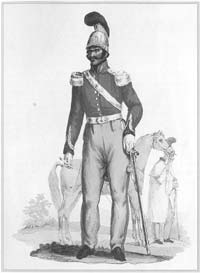A Call to Arms
The Organization of the Mexican Army
A Conversation With William DePalo, Jr.
The University of New Mexico
 The Mexican army of 1846 rostered 18,882 permanent troops (permanentes) organized into 12 infantry regiments (of two battalions each), eight regiments and one separate squadron of cavalry, three brigades of artillery, one dragoon brigade and one battalion of sappers. Supplementing the permanentes were 10,495 active militiamen (activos) apportioned into nine infantry and six cavalry regiments. Commanded by permanent army officers, the militia was supposed to be activated only in times of emergency; in reality, however, most units were retained on active duty indefinitely. Posted along the northern periphery, presidial companies (presidiales) reported 1,174 additional troops. Poorly trained and inadequately outfitted, these frontier units were too far removed to affect the correlation of forces in the main theaters of war.
The Mexican army of 1846 rostered 18,882 permanent troops (permanentes) organized into 12 infantry regiments (of two battalions each), eight regiments and one separate squadron of cavalry, three brigades of artillery, one dragoon brigade and one battalion of sappers. Supplementing the permanentes were 10,495 active militiamen (activos) apportioned into nine infantry and six cavalry regiments. Commanded by permanent army officers, the militia was supposed to be activated only in times of emergency; in reality, however, most units were retained on active duty indefinitely. Posted along the northern periphery, presidial companies (presidiales) reported 1,174 additional troops. Poorly trained and inadequately outfitted, these frontier units were too far removed to affect the correlation of forces in the main theaters of war.
These standing formations were allocated among five territorially delineated military divisions and five commandancies-general. A general staff was in place to coordinate the concentration of brigade and division-size units to practice the linear tactics necessary for conventional battlefield success. The regional dispersal of forces, however, impeded centralized military authority and abetted localism. Proposals to regroup scattered permanent army formations into single garrison divisions where units could train routinely under the supervision of experienced officers were not realized before the outbreak of hostilities with the United States.
This regional force distribution scheme compelled the war ministry to confront foreign aggression with extemporaneous armies assembled from the most readily available formations. Generally, the ranks of these hastily assembled composite armies were filled with conscripts impressed into service via the detested levy (leva). Prone to desertion, mutiny and larceny, such draftees were difficult to train and discipline, but fought reasonably well when led resolutely. The repetitive creation of improvised armies kept Mexican units from acquiring the cohesion and esprit necessary to persevere under trying circumstances. On battlefields where small unit leadership and individual initiative were keys to success, such melded organizations were decidedly disadvantaged.
The lone exception to such improvisation was Division General Mariano Arista's 5,200-man Army of the North. Created in the wake of the loss of Texas to guard the extended Río Grande frontier, it was Mexico's most experienced military formation and the one that engaged General Zachary Taylor's Army of Occupation in all four of the northern campaign's major battles. Redeployed to the Valley of Mexico in July 1847, under the command of Division General Gabriel Valencia, the Army of the North bore the brunt of the action at Padierna and, thereafter, ceased to exist as an effective fighting force.
General Winfield Scott's impending advance into the Mexican heartland prompted the war ministry to activate the Army of the East in March 1847. Commanded by General President Antonio López de Santa Anna, this 11,000-man force was an amalgamation of units posted in central Mexico, fragments from the Army of the North and remnants of the defeated Veracruz garrison. Following its disintegration at Cerro Gordo, the Army of the East was reconstituted under the command of Brigade General Manuel María Lombardini with the survivors of that battle and selected national guard (guardia nacional) battalions. Comprised of both middle and lower class residents of the valley, these national guard troopers had a vested interest in preserving their homes and fought tenaciously to defend the capital's perimeter strongpoints.
Responsibility for interdicting Scott's communications with Puebla and guarding the line from Acapulco to Mexico City was entrusted to the 3,000-man Army of the South. Commanded by the obdurate southern cacique Juan Álvarez, this predominately cavalry formation influenced the war only minimally, until Molino del Rey, when Álvarez' unwillingness to commit his cavalry likely affected the outcome of that engagement. A 3,800-man contingent under the nominal leadership of Division General Nicolás Bravo rounded out the valley campaign's force structure. Designated the Army of the Center, this ad hoc organization was initially positioned to protect the Mexicalzingo-San Antonio line. Thereafter, elements of the Army of the Center participated in the Churubusco bridgehead fight and the defense of Chapultepec.
Lacking established government depots, Mexican soldiers routinely procured supplies from nearby communities or foraged off the land. Since local purchases were habitually compensated with unredeemable drafts on the treasury, troops often went hungry. The army's systemic logistical deficiencies were recompensed, in part, by soldiers' wives and girlfriends (soldaderas) who invariably accompanied each campaign. By performing essential sewing, cooking, maintenance and foraging duties, and ministering to the sick and wounded of both armies, soldaderas made a significant contribution to the Mexican war effort.





